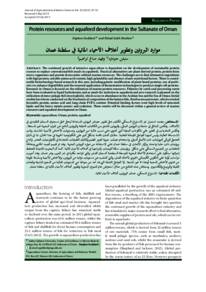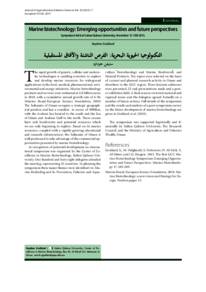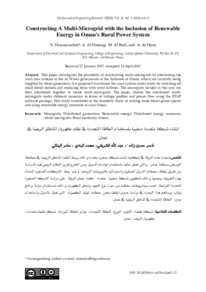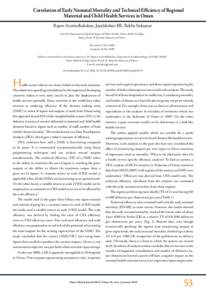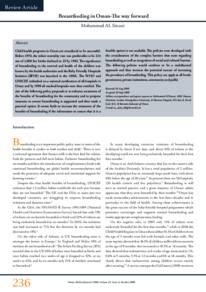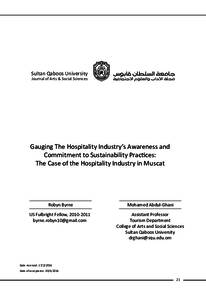Document
Protein resources and aquafeed development in the Sultanate of Oman.
Contributors
Ibrahim, Fahad Saleh., Author
Publisher
جامعة السلطان قابوس. كلية العلوم الزراعية والبحرية
Gregorian
2015
Language
English
Subject
English abstract
The continued growth of intensive aquaculture is dependent on the development of sustainable protein sources to replace conventional fish meals in aquafeeds. Practical alternatives are plant-derived protein, protein from micro-organisms and protein from under-utilized marine resources. The challenges are to find alternative ingredients with high protein, suitable amino acid content, high palatability and absence of anti-nutritional factors. There is considerable biotechnology-based research in this area, including genetic modification of plant-based proteins, use of probiotics to enhance digestibility and the renewed application of fermentation technologies to produce single cell proteins. Research in Oman is focused on the utilization of marine protein resources. Fisheries by-catch and processing waste have been evaluated as liquid hydrolysates and as meals for inclusion in aquafeeds and new research is planned on the utilization of meso-pelagic fish (myctophids), which occur in abundance in the Arabian Sea and the Sea of Oman. Initial studies have been conducted on the biochemical composition of the lantern fish, Benthosema pterotum, which revealed favorable protein, amino acid and long-chain PUFA content. Potential limiting factors were high levels of saturated lipids and the heavy metals arsenic and cadmium. These results will be discussed within a general review of marine resources and aquafeed development in Oman.
Member of
ISSN
2410-1079
Resource URL
Citation
Goddard, S., & Ibrahim, F. S. (2015). Protein resources and aquafeed development in the Sultanate of Oman. Agricultural and Marian Sciences Journal, 20 (1), 47-53.
Arabic abstract
يعتمد استمرار نمو الاستزراع السمكي المكثف عل تطوير مصادر البروتين المستدامة ليحل محل مسحوق السمك التقليدي في الأعلاف. وتكمن البدائل في مشتقات البروتين النباتي، والبروتين المشتق من الكائنات الدقيقة والبروتين الناتج عن الموارد البحرية غر المستغلة. وتكمن التحديات في العثور على المكونات البديلة الي تحتوي على نسب عالية من البروتين، ومستويات الأحماض الأمينية المناسبة، وذات الاستساغة العالية، وليس لديها العوامل المضادة للتغذية. هنالك أبحاث قائمة بشكل كبير على التكنولوجيا الحيوية في هذا المجال، بما في ذلك التعديل الوراثي للبروتينات ذات الأصل النباتي، واستخدام معينات حيوية لتعزيز الهضم وكذلك التطبيقات المتجددة في تكنولوجيات التخمر لإنتاج بروتينات ذات خلية واحدة. وتركز الأبحاث في سلطنة عمان على الاستفادة من موارد البروتين البحرية. وقد تم تقييم الصيد الجانبي ومعالجة المخلفات من التصنيع السمكي على شكل بروتينيات سائلة كوجبات لإدراجها في أعلاف الأحياء المائية. كما أن البحوث الجديدة المخطط إجرائها ستكون على استخدام الأسماك البحرية المتوسطة السطحية كسمك الفنار، والتي تتواجد بكثرة في بحر العرب وبحر عمان. وقد أجريت دراسات أولية على التكوين الكيميائي الحيوي لأسماك الفنار، والتي كشفت عن مستويات مواتية من البروتين، والأحماض الأمينية وسلسلة طويلة من محتوى الأحماض الدهنية أومغا-3 غير المشبعة. إلا العوامل المحتملة التي قد تحد من جودتها هي المستويات العالية من الدهون المشبعة والمعادن الثقيلة والزرنيخ والكادميوم. وستناقش هذه النتائج من خلال استعراض عام للموارد البحرية وتطوير أعلاف الأحياء المائية في سلطنة عمان.
Category
Journal articles

